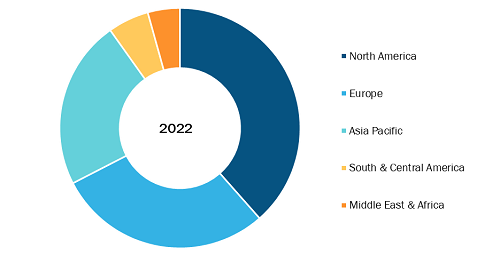The influenza vaccines market size is expected to reach US$ 12,272.49 million by 2028, registering at a CAGR of 7.4% from 2022 to 2028, according to a new research study conducted by The Insight Partners.
Quadrivalent Vaccine Segment to Lead Influenza Vaccines Market During 2022–2028
The report highlights the key factors driving the market and prominent players with their developments. The growth of the influenza vaccines market is primarily attributed to increased government support to promote influenza vaccination and investment by top market players and governments worldwide. However, the high cost of vaccine development is hampering the market's growth.
Influenza Vaccines Market, by Geography, 2022 (%)
Influenza Vaccines Market Forecast to 2028 - COVID-19 Impact and Global Analysis By Vaccine Type (Quadrivalent Vaccines and Trivalent Vaccines), Virus Type (Influenza Virus Type A and Influenza Virus Type B), Technology (Egg-based and Cell-based), Route of Administration (Injection and Nasal Spray), and Target Group (Infants, Children, Adults, and Elderly)
Influenza Vaccines Market Report | Size, Share, Growth by 2028
Download Free Sample
Source: The Insight Partners Analysis
Companies operating in the influenza vaccines market witnessed a positive impact during the pandemic as global campaigns promoted people to get vaccinated against the influenza virus. For instance, in the US, the National Forum for Heart Disease & Stroke Prevention initiated the ‘Move with the Mayor Flu Vaccination Campaign’ where the mayors are protecting their communities from the dual threat of COVID-19 and flu by encouraging people to get vaccinated for flu. Similarly, to reduce the risk of severe illness that could arise from co-infection with SARS-CoV-2 and influenza, the Public Health Agency of Canada (PHAC) released Guidance on the Delivery of Influenza Vaccination in the Presence of COVID-19 to support the delivery of influenza vaccination programs during the COVID-19 pandemic.
- Based on vaccine type, the influenza vaccines market is segmented into quadrivalent vaccines and trivalent vaccines. In 2021, the quadrivalent vaccines segment held a larger market share; however, the same segment is estimated to grow at a faster CAGR during the forecast period. The quadrivalent influenza (flu) vaccine protects against 4 types of influenza viruses, including 2 influenza A viruses and 2 influenza B viruses. All flu vaccines in the US during the 2021-2022 season have been quadrivalent.
- Based on target group, the market can be segmented into infants, children, adults, and elderly. Different vaccines are approved for different age groups. The quadrivalent flu vaccine can be given to children under 6 months of age. Flucelvax Quadrivalent is now approved for people 6 months of age and older. Market players are receiving new product approvals and launching for market expansion. For instance, In Feb 2020, Abbott launched a quadrivalent vaccine for influenza in India.
Moderna, Inc.; SEQIRUS; Sanofi; GlaxoSmithKline plc.; Hualan Biological Engineering Inc.; Emergent BioSolutions Inc.; Mitsubishi Chemical Group Corporation; Serum Institute of India Pvt. Ltd; MYLAN NV; and AstraZeneca are the leading companies operating in the influenza vaccines market.
The report segments the influenza vaccines market as follows:
Based on vaccine type, the influenza vaccines market is segmented into quadrivalent vaccines and trivalent vaccines. Based on virus type, the market is segmented into influenza virus type A and influenza virus type B. Based on technology, the market is segmented into egg-based and cell-based. Based on route of administration, the market is segmented into injection and nasal spray. Based on target group, the market can be segmented into infants, children, adults, and elderly. By geography, the global market is segmented into North America (the US, Canada, and Mexico), Europe (the UK, Germany, France, Italy, Spain, and the Rest of Europe), Asia Pacific (China, Japan, India, Australia, South Korea, and the Rest of Asia Pacific), the Middle East & Africa (the UAE, Saudi Arabia, Africa, and the Rest of the Middle East & Africa), and South & Central America (Brazil, Argentina, and the Rest of South & Central America).
Contact Us Phone: +1-646-491-9876Email Id: sales@theinsightpartners.com